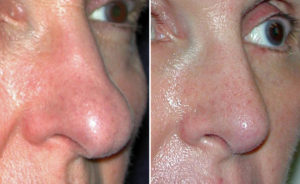
The most common complication from rhinoplasty is an untoward aesthetic result. Most of the time, this is relatively minor such as a bump or irregularity somewhere on the bridge or tip of the nose. The tip of the nose can develop a slight twist or deviation. Nostril irregularities or notching of the columellar skin from the incision can occur. All of these may not be apparent right away. It can take many months after surgery as the final swelling of the nose goes away and the skin adapts back to the cartilage and bony framework which has been changed. Whether these are significant enough to undergo revisional surgery is up to the patient. Many such minor deviations from perfection are well tolerated. For others, these are significant and they want further efforts to achieve the best result possible.
Some more typical surgical complications, such as bleeding and infection, are very uncommon in rhinoplasty. If combined internal nasal airway has not been done, then the risk of bleeding is quite negligible. Infection is similarly rare unless a synthetic material or artificial graft has been used. Then the long-term risks of infection and implant exposure and extrusion are real considerations.
When it comes to foreign materials, most rhinoplasties require some suturing of the rearranged cartilage framework. While the small sutures used on the cartilage are dissolveable, they can take some time to go away often a year or more. It is possible in the interim to develop a raised area or bump which is likely a reaction to the suture or an inflammatory reaction to the dissolving process. This is most commonly seen in the tip area of the nose.
Cartilage grafting is a key part of some rhinoplasties and complications from the donor sites can also occur. These would include the potential for holes (septum), ear pain and deformity (concha) and persistent pain. (rib) Donor site complications are usually short-lived and rarely require secondary surgery to fix them.
While the acceptance of complications is part of every cosmetic procedure, such issues in rhinoplasty take on special significance due to the central position of the nose on the face. No one knows the exact likelihood that any of these will happen or whether revisional rhinoplasty will be needed. It is fair to say that the majority of rhinoplasty surgeries suffer no such complications (> 90%) but the risk is a real one and revisional rhinoplasty surgery is not rare. (<10%) Even the most ideally executed rhinoplasty operation is exposed to the unpredictable forces of scar contracture and cartilage warping that can occur from the healing process.
Dr. Barry Eppley
Indianapolis, Indiana


